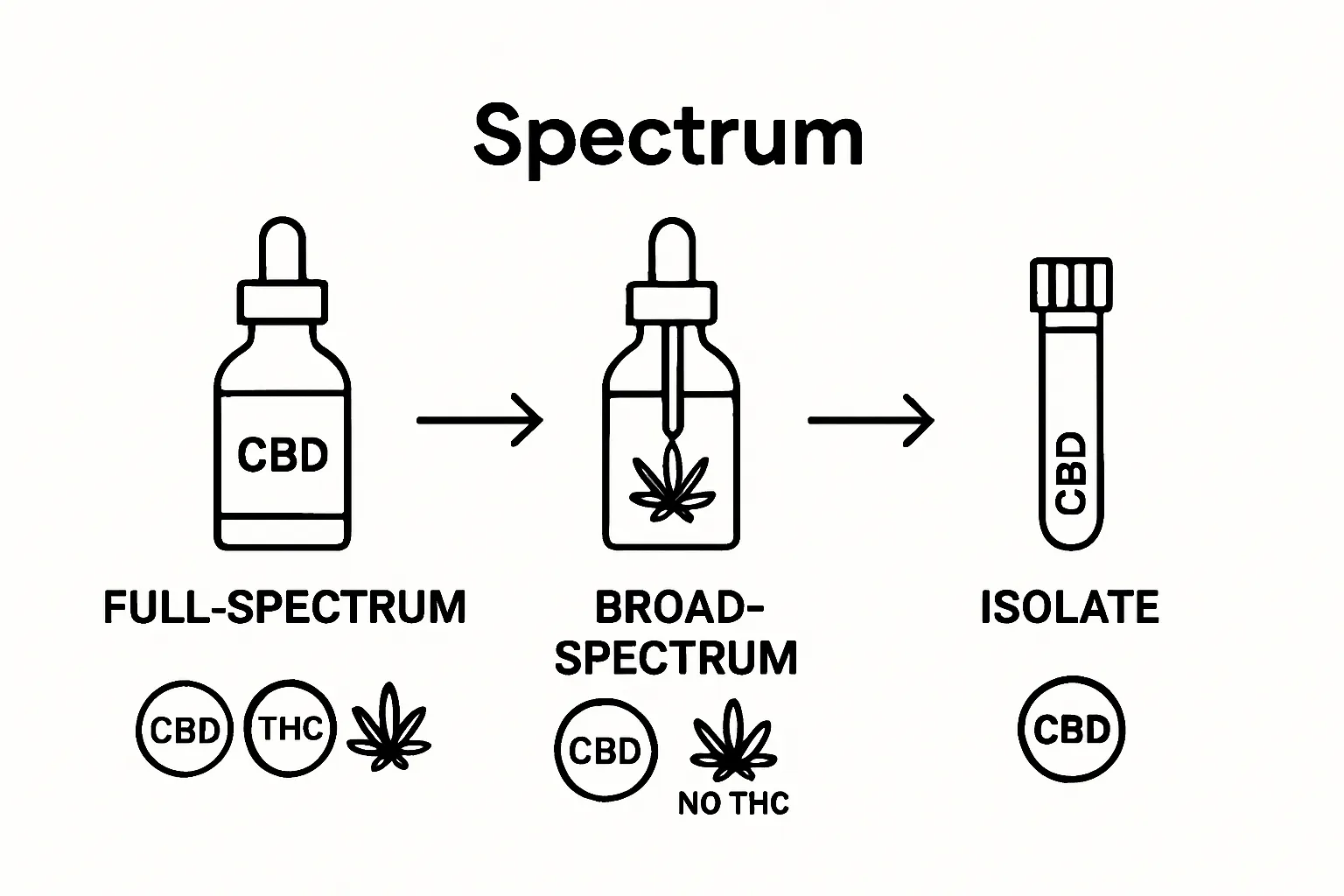CBD has captured attention for its promise in everything from relaxation to recovery. Yet, most people do not realize that hemp-derived CBD legally contains less than 0.3 percent THC, setting it apart from its mind-altering cousin. While the buzz is often about getting high, the real story is how CBD works without the high and why scientists are digging deeper into its unexpected benefits.
Table of Contents
- What Is Cbd And Its Origins
- Why Cbd Matters In The Cannabis Industry
- How Cbd Interacts With The Body
- Key Concepts Of Cbd: Full-Spectrum, Broad-Spectrum, And Isolate
- Real-World Applications: Cbd Uses And Benefits
Quick Summary
| Takeaway | Explanation |
|---|---|
| CBD is non-psychoactive | Unlike THC, CBD does not produce intoxicating effects, making it appealing for therapeutic use. |
| Legal sources are primarily hemp | Hemp plants, containing less than 0.3% THC, are the main source of legally extracted CBD. |
| CBD interacts with the endocannabinoid system | CBD influences bodily functions by modulating receptors involved in pain, mood, and immune responses. |
| Multiple product types exist | CBD comes in full-spectrum, broad-spectrum, and isolate forms, each offering different benefits and compositions. |
| Potential applications in mental and physical health | CBD may assist with anxiety, pain management, and inflammation, making it versatile in wellness and recovery. |
What is CBD and its Origins
Cannabidiol, commonly known as CBD, represents a fascinating natural compound derived from cannabis plants. Unlike its more infamous counterpart THC, CBD offers unique therapeutic potential without producing psychoactive effects. Researchers at the National Institutes of Health have extensively studied this compound, revealing its complex molecular structure and potential health applications.
The Botanical Foundations of CBD
CBD originates from both hemp and marijuana plants, which are members of the cannabis sativa family. While these plants share genetic similarities, their chemical compositions differ significantly. Hemp plants typically contain higher CBD concentrations with minimal THC levels (less than 0.3%), making them the primary source for legal CBD extraction.
Key botanical characteristics of CBD sources include:
- Predominantly found in the plant’s flowers and leaves
- Extracted through various methods like CO2 extraction and solvent-based techniques
- Naturally occurring in both industrial hemp and cannabis varieties
Scientific Discovery and Understanding
The scientific journey of CBD began in the 1940s when researchers first isolated the compound. Dr. Roger Adams at the University of Illinois was among the pioneering scientists who identified CBD’s molecular structure. However, comprehensive understanding of its potential therapeutic applications emerged decades later, particularly in the late 20th and early 21st centuries.
According to research published in the British Journal of Pharmacology, CBD interacts with the human endocannabinoid system, a complex cell-signaling network responsible for maintaining physiological homeostasis. This interaction occurs through cannabinoid receptors located throughout the body, potentially influencing various biological processes including mood, pain perception, and immune response.
Understanding CBD requires recognizing its unique position as a non intoxicating compound with potential therapeutic applications across multiple health domains.
Why CBD Matters in the Cannabis Industry
The cannabis industry has experienced unprecedented growth, with CBD emerging as a transformative compound driving significant market expansion and regulatory interest. According to FDA research, CBD represents a complex landscape of potential medical applications and economic opportunities.
Economic and Therapeutic Potential
CBD has become a major economic force, creating new markets and opportunities across multiple sectors. The compound’s versatility extends beyond medical applications, penetrating wellness, skincare, nutrition, and therapeutic industries. Companies are investing heavily in research and product development, recognizing CBD’s potential to address various health concerns.
Key economic indicators for CBD include:
- Projected global market value estimated at billions of dollars
- Growing consumer demand across demographic segments
- Increasing acceptance in medical and wellness communities
Regulatory Landscape and Scientific Interest
Regulatory frameworks surrounding CBD continue to evolve, reflecting its complex scientific profile. Government agencies and research institutions are actively studying its potential therapeutic benefits and safety profiles. Check out our guide on understanding cannabis beverages to explore how CBD is transforming product innovation.
Researchers are particularly interested in CBD’s potential applications in:
- Anxiety and stress management
- Pain and inflammation reduction
- Neurological disorder treatments
- Sleep improvement mechanisms
The cannabis industry’s embrace of CBD signals a significant shift towards more nuanced, scientifically-backed approaches to plant-based wellness solutions. By prioritizing research, transparency, and responsible innovation, CBD is reshaping perceptions of cannabis from a recreational substance to a potential therapeutic tool with wide-ranging implications for health and wellness.
How CBD Interacts with the Body
CBD engages with the human body through a complex network of biological mechanisms, primarily involving the endocannabinoid system. Research from Harvard Medical School highlights the nuanced ways this compound influences physiological processes without producing intoxicating effects.
The Endocannabinoid System Overview
The endocannabinoid system represents a sophisticated cell-signaling network critical to maintaining bodily homeostasis. This intricate system comprises cannabinoid receptors, endogenous cannabinoids, and metabolic enzymes distributed throughout the body. CBD interacts indirectly with two primary receptor types: CB1 (predominantly in the central nervous system) and CB2 (primarily in peripheral systems and immune cells).
Key characteristics of CBD interaction include:
- Non psychoactive molecular engagement
- Modulatory effect on receptor signaling
- Potential regulation of neurotransmitter release
- Complex interactions with multiple physiological pathways
Molecular Mechanisms of CBD
Unlike THC, CBD does not directly bind to cannabinoid receptors. Instead, it influences these receptors indirectly, potentially modulating their activity and supporting overall system balance. Learn more about our comprehensive cannabis product insights to understand these intricate interactions.
Important physiological systems potentially influenced by CBD include:
- Nervous system neurotransmission
- Immune system response regulation
- Inflammatory pathway modulation
- Pain perception mechanisms
Scientific investigations suggest CBD may interact with several non-cannabinoid receptors, including serotonin and vanilloid receptors. This multifaceted interaction explains the compound’s potential therapeutic versatility, ranging from stress reduction to potential neuroprotective properties. The complexity of these interactions underscores why researchers continue to explore CBD’s wide ranging biological impacts.
Key Concepts of CBD: Full-Spectrum, Broad-Spectrum, and Isolate
CBD products come in diverse formulations, each offering unique characteristics and potential benefits. Research published in the European Journal of Medicinal Chemistry highlights the nuanced differences between these CBD types, helping consumers make informed choices.
Understanding CBD Product Categories
The three primary CBD classifications represent distinct extraction and processing approaches, each with specific composition and potential therapeutic implications. These categories differentiate themselves based on the range of cannabis plant compounds present in the final product.

Key distinguishing features include:
- Varying levels of additional cannabinoids
- Presence or absence of THC
- Extraction method and processing complexity
- Potential interaction with the endocannabinoid system
Detailed Breakdown of CBD Types
Full-spectrum CBD contains all naturally occurring cannabis plant compounds, including trace amounts of THC (typically under 0.3%), terpenes, and minor cannabinoids. Broad-spectrum CBD offers a similar profile but with THC completely removed. Learn more about our cannabis beverage insights to understand product variations.
Important considerations for each CBD type:
- Full-spectrum: Potential “entourage effect” from combined compounds
- Broad-spectrum: THC-free option with multiple cannabinoid benefits
- Isolate: Pure CBD with no additional plant compounds
CBD isolate represents the most refined form, containing 99% pure cannabidiol without any other cannabis plant elements. This pure form offers precise dosing and zero risk of THC exposure, making it attractive for individuals seeking targeted CBD consumption without additional plant compounds. The choice between these formats depends on individual wellness goals, legal considerations, and personal preferences.
To help readers compare the main types of CBD products, the table below summarizes key characteristics, compound content, and potential benefits for each category.
| CBD Type | Compound Content | THC Content | Key Features | Potential Benefits |
|---|---|---|---|---|
| Full-spectrum | All cannabinoids, terpenes, flavonoids | Trace (<0.3%) | “Entourage effect” from multiple plant compounds | Broad therapeutic potential |
| Broad-spectrum | Multiple cannabinoids and terpenes, no THC | None | THC-free while retaining other plant compounds | Benefits without THC exposure |
| Isolate | Pure cannabidiol (CBD), no other plant compounds | None | 99%+ pure CBD, precise dosing | Targeted CBD effects, no risk of THC |
Real-World Applications: CBD Uses and Benefits
CBD has emerged as a versatile compound with potential applications across multiple health and wellness domains. Research from the National Institutes of Health demonstrates the expanding understanding of CBD’s therapeutic potential across various physiological systems.
Wellness and Mental Health Applications
In the realm of mental health, CBD shows promising potential for addressing anxiety, stress, and mood regulation. Researchers have observed its potential to interact with serotonin receptors, which could explain its potential calming and stabilizing effects. These interactions suggest CBD might offer alternative approaches to managing psychological wellness without the side effects associated with traditional pharmaceutical interventions.
Key mental health considerations include:
- Potential reduction of generalized anxiety symptoms
- Support for stress management techniques
- Possible mood stabilization mechanisms
- Non intoxicating therapeutic approach
Physical Health and Recovery Benefits
Beyond mental wellness, CBD demonstrates potential in addressing physical health challenges. Scientific investigations suggest its potential anti inflammatory properties and pain management capabilities. Athletes and individuals managing chronic conditions have shown increasing interest in CBD as a natural alternative for recovery and symptom management. Check out our cannabis edibles safety guide to understand responsible consumption approaches.
Notable physical health applications include:
- Potential chronic pain management
- Possible reduction of exercise induced inflammation
- Support for muscle recovery processes
- Potential neuroprotective properties
While research continues to evolve, CBD represents a fascinating intersection of natural wellness and scientific exploration. Its multifaceted potential spans mental and physical health domains, offering individuals alternative approaches to managing their overall well being. Ongoing research promises to unlock even more comprehensive understanding of this remarkable compound.
The following table organizes how CBD may be applied for mental wellness and physical health, highlighting the specific focus areas and notable properties mentioned in the article.
| Application Area | Focus | Related Benefits and Properties |
|---|---|---|
| Mental Health | Anxiety, stress, mood | Potential anxiety reduction, mood stabilization, non-intoxicating approach |
| Physical Recovery | Pain, inflammation, muscle | Possible chronic pain management, anti-inflammatory effects, muscle recovery support |
| Neurological Health | Neuroprotection | Potential neuroprotective properties |
| Sleep | Sleep quality | Sleep improvement mechanisms (research ongoing) |

Ready to Experience CBD’s Benefits for Yourself?
You just learned how CBD works with your body, from supporting the endocannabinoid system to addressing concerns like anxiety, pain, and sleep. But finding pure, effective products can feel overwhelming. Many people struggle to trust what they buy, especially with confusing labels or vague ingredient lists. If you care about verified quality and transparent sourcing, you should not have to guess about what you are putting in your body.

Take control of your wellness journey today. At Avondale Apothecary, our curated selection covers everything from full-spectrum options to CBD isolates, supported by detailed Certificates of Analysis for every product. Explore our collection and discover the difference that transparency and quality make. Visit Avondale Apothecary’s main site now to shop confidently and join a community that puts your health and peace of mind first.
Frequently Asked Questions
What is CBD and how is it derived?
CBD, or cannabidiol, is a natural compound found in cannabis plants, primarily derived from hemp, which contains higher concentrations of CBD and minimal THC (less than 0.3%).
How does CBD interact with the body?
CBD interacts with the human endocannabinoid system, engaging with cannabinoid receptors to potentially influence processes such as pain perception, mood regulation, and immune response without producing psychoactive effects.
What are the different types of CBD products?
The three main types of CBD products are full-spectrum (containing all cannabis plant compounds including trace THC), broad-spectrum (THC-free), and isolate (pure CBD without other compounds). Each type has unique characteristics and potential benefits.
What are the potential benefits of using CBD?
CBD shows potential benefits for mental and physical health, including anxiety reduction, stress management, pain relief, and support for muscle recovery. Research is ongoing to fully understand its therapeutic applications.

